|
NATIONAL UNIVERSITY OF RWANDA
FACULTY OF ECONOMICS AND MANAGEMENT
DEPARTMENT OF APPLIED STATISTICS
ANALYZING THE CONTRIBUTION OF HIGHER LEARNING
INSTITUTIONS ON RURAL DEVELOPMENT IN RWANDA: Case of the Study SPREAD-NUR and
ABAHUZAMUGAMBI COFFEE COOPERATIVE MARABA
By
HABYARIMANA
Jean Baptiste
Huye, October 2010
Declaration
I, HABYARIMANA Jean Baptiste, hereby declare that, the work
presented in this dissertation entitled «ANALYZING THE CONTRIBUTION OF
HIGHER LEARNING INSTITUTIONS ON RURAL DEVELOPMENT IN RWANDA: Case of The Study
SPREAD-NUR and ABAHUZAMUGAMBI COFFEE COOPERATIVE MARABA» is my
original work and has never been presented elsewhere for any academic award.
All consulted references have been systematically presented in
references.
Signature: .........................
HABYARIMANA jean Baptiste
Date: .................................
Dedication
I dedicate this Dissertation to :
God,
My family,
And
Friends.
Acknowledgement
The success of this research work cannot be solely be
attributed to the effort of one person. In fact, there must be combined efforts
to make such exercise a success. It is therefore on this ground that other
people deserve my sincere thanks and gratitude.
Thanks to my family, relatives, and friends for their help
either materially or morally.
I would like to address my special thanks to anyone who
directly or indirectly contributes to the success of my study.
Table of contents
Declaration
i
Dedication
ii
Acknowledgement
iii
Table of contents
iv
List of Tables
v
List of Figures
vi
List of abbreviations
vii
Abstract
viii
CHAPTER ONE: INTRODUCTION
9
1.1. General introduction
9
1.2. Background
3
1.3. Statement of the problem
4
1.4. OBJECTIVES OF THE STUDY
5
1.4.1. General objective
5
1.4.2. Specific objectives
5
1.5. Research Hypothesis
5
1.6. Research Questions
5
1.7. Significance
5
1.8. Scope of the Study
6
1.9. Limitations
6
CHAPTER TWO: LITERATURE REVIEW
6
2.1. Introduction
6
2.2. Introduction to Higher Education for Rural Development
6
2.3. Rural development, Sustainable Rural development and Rural
Public works projects
7
2.3.1. Rural development
7
2.3.2. Sustainable
8
2.3.3. Rural Public works projects
8
2.4. Rural Banks, Credit Cooperatives, and development of rural
markets
8
2.5. Development actions
9
2.6. Mission, Vision, Commitment Of Higher Learning Institutions
10
2.7. Challenges Faced By Institutions In Meeting Their Missions
11
2.8. Education's Role in Development
15
2.9. Three dimensions of inclusive rural development
15
CHAPTER THREE: METHODOLOGY
16
3.1 Introduction
16
3.2. Research Design
17
3.3. Conceptual Framework and Methods Of Data Gathering
17
3.4. Sampling Method and Sampling Size
18
3.6. Data Collection
18
3.6.1. Primary Data
18
3.6.2. Secondary data
19
3.7. Data Analysis
19
CHAPTER FOUR: DATA PRESENTATION, ANALYSIS, AND INTERPRETATION
20
4.1. Level of Empowerment and Status of Development
21
4.2. Demographic Characteristics of the Respondents
21
4.2.1. Distribution by Age and Sex
21
4.2.2. Distribution by marital status
22
4.2.3. Occupation and Education Level characteristics of
respondents Household size
23
4.3. Coffee production and Quality of production
25
4.3.1. Coffee Plantation and production
25
4.3.2. Washing System
26
4.3.3. Use of Fertilizer, Pesticides, and Pest control
26
4.3.4. Channels of produced quantity
27
4.4. Perception toward Income generating which increases earnings
28
4.5. Perception toward Food Security
29
4.6. Perception toward Basic health and HIV and AIDS
32
4.7. Perception toward Environment
34
4.8. Perception toward Rural Development
36
CHAPTER V. CONCLUSION AND RECOMMENDATIONS
38
5.1. Conclusion
38
5.2. Recommendations
40
REFERENCE
41
Appendices
List of Tables
Table 1. Marital status
22
Table 2. Occupation by Respondents
23
Table 3. Household size
24
Table 4. Coffee trees
24
Table 5. Coffee production in Kgs
24
Table 6. Income from coffee
25
Table 7. Washing System
25
Table 8. Bank Account
27
Table 9. Income Generating activities
28
Table 10. Food condition
29
Table 11. Improvement in food served
30
Table 12. Environmental threats and problems
33
Table 13. Main Sources of lighting energy
35
Table 14. Empowerment
36
Table 16. Inclusive Rural Development
36
List of Figures
Figure 1. Three dimensions of inclusive rural development
15
Figure 2. Sex distribution
21
Figure 3.Distribution of respondents by Age and sex
21
Figure 4. Marital Status of Respondents
22
Figure 5. Occupation of Respondents
23
Figure 6. Education level of respondents
23
Figure 7. Distribution of Coffee production
24
Figure 8. Coffee washing system
25
Figure 9. Use of Inorganic fertilizer and Pesticides
26
Figure 10. Contribution of SPRAED-NUR on Coffee production
26
Figure 11. Main Channel of coffee production
27
Figure 12. Income generating activities
28
Figure 13. Main source of income to start income generating
projects
28
Figure 14. Food condition
29
Figure 15. Meals in take per day
29
Figure 16. Food control
30
Figure 17. Food improvement
30
Figure 18. Main source of information on basic health and
HIV/AIDS
31
Figure 19. Health activities
32
Figure 20. Health situation
32
Figure 21. Environmental threat and problems
33
Figure 22. SPREAD-NUR and natural resource protection
34
Figure 23. Means of getting information
34
Figure 24. Main sources of lighting energy
35
List of abbreviations
EFA Education for All
KIE Kigali Institute of
Education
KIST Kigali Institute of Science,
Technology and Management
ERP Education for rural
people
FAO Food and Agriculture
Organization
HESORD Higher Education System on Rural
Development'
IIEP International Institute for
Educational Planning
MDGs Millennium Development Goals
NGOs Non Government
Organizations
NUR National University of
Rwanda
SPREAD Sustainable Partnership to
Enhance Rural Enterprises and Agribusiness Development
UCO University of Cordoba
UNESCO United Nations Education, Science,
and Cultural Organization
Abstract
Rural areas are facing major challenges today which arise
mainly from globalisation, demographic change and the rural migration of young,
well-trained people. Policies for rural areas aim to contribute to recognising
and making use of strengths and opportunities.
The rationale of this study is to describe how higher learning
institutions is contributing to rural development in Rwanda, this target has
been reached by studying empowerment approach tackles composed of six
components vulnerable to the poor like basic health/HIV and AIDS, Rural
Development, income generation, food security, environment, and education.
These elements are assessed concerning the World Bank's four indicators: access
to information, inclusion and participation, accountability, and local
organizational capacity. Another insight is to disclose the opinion of the
people toward the development status of rural area before and after
SPREAD-NUR's assistance. Although the finding in this research showed that all
six aspects are improving in terms of development, the people are not empowered
in all six. Exceptions are in basic health, and environment. The common
misconduct is accountability from concerned parties.
Overall, the people appreciate on SPREAD-NUR's services and
perceive that the community is developing in positive direction. To improve the
gaps above, it is recommended to strengthen on National University's
implication in Rural Development enforcement and policy intervention. Selection
of region of interest should be considered carefully while public services
should be improved and standardized. The community common interest should be
prioritized as well. Finally the next leaps of development should be studied
and further investigated. This dissertation is a contribution of the
SPREAD-NUR's knowledge on community development by empowerment approach in
rural development of Rwanda.
CHAPTER ONE:
INTRODUCTION
1.1. General
introduction
Rural areas are facing major challenges today which arise
mainly from globalisation, demographic change and the rural migration of young,
well-trained people. Policies for rural areas aim to contribute to recognising
and making use of strengths and opportunities. (Taylor P and J Fransman,
2004).
Rural Planning in Rwanda aims to assist local stakeholders to
use information for managing their natural resources by providing methods,
tools, documented examples, and principles (or insights) that would help bring
about successful planning, monitoring, and evaluation. Land-use
administrations, institutions, and stakeholder groups can use planning,
monitoring, and evaluation as mechanisms for rural development. Scientists and
information providers can use them as entry points into development.
More than 79.8% of Rwanda's population are to be found in
rural areas where hunger, literacy and low school achievement are common.
Education for a large number of people in rural areas is crucial for achieving
sustainable development in rural areas of Rwanda. Poverty education strategies
are now placing emphasis on rural development that encompasses all those who
live in rural areas (World Bank, 2008).
Rapidly changing technologies and increasing globalization
also suggest that better education and training have become essential for
sustainable livelihoods and rural economy competitiveness (FAO/UNESCO Seminar,
5-7 November 2002)
In 1997, the Kigali Institute of Science, Technology and
Management (KIST) was formed in Rwanda to address the serious loss of
professional manpower. In 2005 it was awarded the Ashden Award for sustainable
Energy for the large scale innovative implementation and use of Biogas System
within the Rwandan Prisons (
http://ivorhartmsnn.blogspot.com/2007/12/human-biogas-solution-whose-time-has.html
accessed on 19 September 2010).
Kigali Institute of Education (KIE) is promoting Distance
Learning, and the Ministry of Education believes that the promotion of Distance
Leaning Policy Statement on teacher training and Management will set a clear
road map for professionalizing the teaching profession in Rwanda and help to
raise the status of teachers both economically and socially. The Ministry also
believes that efforts to improve teachers' capabilities to inculcate the right
kind of values attitudes and skills that will enable the children to become
productive citizens, will translate into real investment in the national
development context (Republic of Rwanda, Ministry of Education, 2007).
Nowadays, the approach followed by policy-makers and education
specialists in developing Countries is to focus on practical and occupational
agriculture skill training provided mainly at the secondary and tertiary
levels. Yet, in an environment increasingly shaped by non-farming activities
linked to farming activities, and in policy context dominated by the poverty
reduction agenda through the development of commercial farming or cash-crops;
education for rural development requires a holistic approach going beyond the
narrow boundaries of the traditional agricultural education and training
concept (Faustine K.Bee, 2001)
It is in this case that SPREAD in collaboration with National
University of Rwanda has created a partnership to monitor ABAHUZAMUGAMBI
Cooperative of MARABA coffee producer; The main objectives are to promote
MARABA Coffee on international level by providing methods, tools, documented
examples, and principles (or insights) to the producer of MARABA coffee that
would help bring about successful planning, monitoring, and evaluation while
improving the value added of MARABA coffee, promoting social wellbeing of
MARABA coffee producer and targeting rural development.
1.2. Background
In order for the producer of MARABA Coffee to take advantage
of opportunities for growth presented by coffee production and other sectors,
and to overcome supply side constraints, farmers and entrepreneurs of MABARA
Coffee are being supported through technical assistance and investment in
infrastructure and institutions by SPREAD and National University of Rwanda.
Recognizing the limitations faced by the farmers of MARABA
Coffee to individually access on credit buyers, and low production with
critical quality SPREAD-NUR is working closely with ABAHUZAMUGAMBI Cooperative
to develop a range of coffee production, marketing and credit services for
these farmers with significant outcomes. And as targeted by SPREAD-NUR, the
value-adding activities of supporting the development of central pulpery
processing, credit access, improved marketing and the development of new
business models for Coffee translate into higher revenues, more income and
improved social wellbeing for the rural poor therefore rural development.
Rural development refers to the actions and initiatives taken
to improve the standards of living in non urban neighbourhoods, countryside,
and remote villages. These communities can exemplify with a low ratio of
inhabitant to open space.
World rural population are estimated to 57% in 1990 and 50.5%
in 2006, with 30% of land is covered by forests in 2005, with also permanent
cropland 1.1% in 2005, arable land 11% (World Bank, 2008).
The programs of rural development are not concerned only with
the developing world; also the developed countries have very active rural
development programs. The main aim of the rural government policy is to develop
the underdeveloped villages.
Rwanda known as a land of the thousand hills is a small
country in central Africa and one of the most densely populated nations. Rwanda
has experienced a series of civil and ethnics conflicts since the late 1950s.
In 1994 one million Rwandan people dead and displacing half of the country's
population
2008, 79.8% of Rwandans live in rural areas, with an average
growth rate of 0.6% on the land area of 24.7 thousand km2 (in 2007),
with a permanent cropland of 11.1% of land area in 2005, arable land 48,6% in
2005 (World Development Indicators, 2008).
Since this difficult period, and taking into account of the
percentage of the rural population, the government of Rwanda has sought to
rebuild the country by improving its governance. Rwanda poverty reduction
strategy paper focuses on poverty reduction, and the country's sustainable
economic development.
1.3. Statement of the
problem
Rwanda is a densely populated country in which a large
majority of the population depends on agriculture for subsistence. Major axes
of this sector are food security, sustainable use of soil and water protection
and good management of the forests, as well as biodiversity conservation and
environment promotion.
Rural development actions mostly aim at the social and
economic development of the areas. This program is usually top down from the
local or regional authorities, regional development agencies, NGOs, National
government or international development organizations.
However rural development actions in Rwanda are still in its
emerging stages, this is why the sustained rural development is still doubtful
in Rwanda. Therefore this study will analyze the contribution of higher
learning institutions in rural development of Rwanda.
1.4. OBJECTIVES OF THE
STUDY
1.4.1. General objective
The general objective of this study is to analyze the
contribution of higher learning institution on rural development in Rwanda.
1.4.2. Specific objectives
The study aimed at achieving the following specific
objectives:
· To identify the role played by National University of
Rwanda in rural development of Rwanda.
· To understand the community's perception to
SPREAD-NUR's contributions.
· To recommend measures and model of empowerment to
enhance the effectiveness of SPREAD-NUR in promoting rural development in
Rwanda.
1.5. Research Hypothesis
Higher learning institutions contribute to the process of
Rural Development in Rwanda.
1.6. Research Questions
· Do higher learning institutions in Rwanda have an
impact on rural development in Rwanda?
· Is NUR contributing in rural development in Rwanda
especially in HUYE district where it is located?
· Is SPREAD-NUR's partnership significantly influencing
rural development basing on ABAHUZAMUGAMBI Cooperative members?
1.7. Significance
The research will provide insights into important partnership
issues between SPREAD-NUR and rural community. It will try to measure levels of
empowerment from various aspects of SPREAD-NUR's contributions.
The study will attempt to develop empowerment models,
strategies and tools for developing rural communities. The study will also
looks into the roles of SPREAD and NUR in rural development. All in all, it
unlocks and makes way for effective poverty reduction strategies based on
current perspectives which can be applied widely to handle MDGs and harmonize
cooperation among the key actors: civil society, the governments, and people.
1.8. Scope of the Study
This study will be conducted in HUYE District, using the
selected Higher learning Institution National University of Rwanda in
collaboration with SPREAD to understand how they are influencing rural
development. And will only select the empowerment approach because it is the
focus of the project and is a new mechanism evolving in the development program
in Rwanda. There are many aspects to concentrate on but the study tends to
program effectiveness from the viewpoint of degree of satisfaction, objective
attainment, and perception and well being of coffee farmers grouped in
ABAHUZAMUGAMBI Cooperative.
1.9. Limitations
A limitation identifies potential weakness in the research.
One of the weaknesses in this research is that the researcher could not get
some of required data because of the respondents. Also because of limited time
and resources, this study was only limited to some of the aspects of Rural
development.
CHAPTER TWO: LITERATURE
REVIEW
2.1. Introduction
This part gives an overall review of existing literature it
covers theoretical framework definitions of key concepts and different theories
about them. The overall purpose of this review is to know about the result of
studies related to topics under study.
2.2. Introduction to Higher
Education for Rural Development
Education for rural people is crucial to achieving
both the Education for All (EFA) goals, and the Millennium Development Goals
(MDGs) of eradicating extreme poverty and hunger, ensuring universal primary
education by 2015, promoting gender equity and ensuring environmental
sustainability. (Eduardo Ramos and María Del Mar Delgado; 2005).
In 1996, the World Food Summit in Rome stressed increased
access to education for the poor and members of disadvantaged groups, including
rural people, as a key to achieving poverty eradication, food security, durable
peace and sustainable development. The 2002 World Summit on Sustainable
Development, held in Johannesburg, also emphasized the role of education.
As the majority of the world's poor, illiterate and
undernourished live in rural areas, it is a major challenge to ensure their
access to quality education. The lack of learning opportunities is both a cause
and an effect of rural poverty. Hence, education and training strategies need
to be integrated within all aspects of sustainable rural development, through
plans of action that are multisectoral and interdisciplinary. This means
creating new partnerships between people working in agriculture and rural
development, and people working in education. (Eduardo Ramos and María
Del Mar Delgado; 2005).
To address this challenge, the Directors-General of FAO and
UNESCO jointly launched the flagship programme on Education for rural
people (ERP) in September 2002 (http://www.fao.org/sd/erp/),
during the World Summit on Sustainable Development.
This initiative involves an inter-agency approach to
facilitate targeted and co-ordinated actions for education in rural areas. It
is within this framework, and to provide inspiration for the flagship
initiative, that the FAO's Extension, Education and Communication Service and
UNESCO's International Institute for Educational Planning (IIEP) have jointly
launched a series of publications. This series is co-ordinated and edited by
David Atchoarena (IIEP) and Lavinia Gasperini (FAO). (Eduardo Ramos and
María Del Mar Delgado; 2005).
2.3. Rural development,
Sustainable Rural development and Rural Public works projects
2.3.1. Rural development
Rural development in general is used to
denote the actions and initiatives taken to improve the standard of living in
non-Urban neighbourhoods, countryside, and remote villages. These communities
can be exemplified with a low ratio of inhabitants to open space. Agricultural
activities may be prominent in this case whereas economic activities would
relate to the primary sector, production of foodstuffs and raw materials.(
www.wikipedia.org)
Rural development is also multi-dimensional and much broader
than poverty alleviation through social programmes and transfers; it places
emphasis on changing environments to enable poor people to earn more, invest in
themselves and their communities and contribute toward maintenance of key
infrastructure; a successful strategy will make people less poor, rather then
more comfortable in their poverty (Cheam Phan Viriya, 2009)
2.3.2. Sustainable
sustainability is derived from increased local growth, and
were rural people care about success and are able to access resources to keep
the strategy going (Calestous Juma, 2000) and there are some
aspirational statements on this theme, the most commonly quoted being
Brundtland's: «development which meets the needs of the present without
compromising the ability of future generations to meet their own needs»
(in Custance & Hillier, 1998).
2.3.3. Rural Public works
projects
Rural Public works projects is the creation of rural
infrastructure through the mobilization of rural labour has long been the dream
of economic planners in developing world. The idea is simple one. In the end of
agricultural season, labour in the rural sectors of developing nations is
unemployed or underemployed. Therefore the opportunities cost of using that
labour on rural public works projects is zero or near zero ( although food
consumption may go up for people doing heavy construction work) (Malcolm Gills,
et al.; 1987).
2.4. Rural Banks, Credit
Cooperatives, and development of rural markets
A second approach to the problem of providing
rural areas with sufficient capital for development is to establish rural banks
or credit cooperatives that will lend to farmers. In traditional agriculture a
farmer has only two sources of credit: members of this family and the local
moneylender. Because their location, urban banks lack the knowledge and skills
necessary to operate effectively in rural areas.
On the other hand, local moneylenders know the reliability of
the people to whom they are lending and the quality of land put up as
collateral. Individuals without land, of course, have difficulty getting money
even from local moneylenders. (Malcolm Gills, et al. ; 1987).
Credit cooperatives set up by the small farmers are one
potential solution to this problem. The idea is that each farmer is capable of
saving a small sum, and if these sums are pooled, one or two farmers can borrow
a substantial sum to buy a new thresher or pump.
The next year it will be another farmer's turn and son on. In
the meantime those who put their money in the cooperative will draw interest,
thus encouraging them to save more. But this approach has flaws.
Farmers' savings tend to be small, and hence the cooperative
tend to be financially weak. More seriously, farmers in developing nations have
little experience relevant to the effective operation and management of
cooperatives. In addition, economic, social, and political conflicts within the
village may make it possible to decide something as simple as who get the next
loan. (Malcolm Gills, et al.; 1987)
There are virtually no areas of the world today where
substance farming in its purest form still exists. Economic of development is
usually accompanied by the increasing size and sophistication of this rural
marketing network, and in turn that improved net work has an important impact
on productivity in agriculture. The key to an increasing role for the market is
specialization, and specialization depends on economies of scale, low - cost
transport, and acceptable risk. (Malcolm Gills, et al.; 1987)
2.5. Development
actions
Rural development actions mostly aim at the social and
economic development of the areas. These programs are usually top-down from the
local or regional authorities, regional development agencies, NGOs, national
governments or international development organizations. But then, local
populations can also bring about endogenous initiatives for development. The
term is not limited to the issues for developing countries. In fact many of the
developed countries have very active rural development programs. (
www.wikipedia.org)
2.6. Mission, Vision,
Commitment Of Higher Learning Institutions
Universities were originally set up as a response to certain
needs of society which no other institution or group could meet. However, this
role, which clearly differentiated the functions and activities of
universities, has become blurred. With the passage of time, other institutions
have begun to concern themselves with research and teaching, sharing these
functions with universities or on occasion even surpassing or substituting
them.
For these reasons, universities today must rethink their
social function. In order to do so, they must explain questions such as their
`mission', the `vision' of this mission and their institutional `commitment'
towards society. Something which was considered obvious for a long time must
now be reformulated and may be the cause of comparative and competitive
advantages between universities, since, for the first time in their history;
these institutions face a profound questioning of the principles which have
governed them up to now. (Eduardo Ramos and María Del Mar Delgado;
2005).
The `mission' of the university is linked to intellectual
excellence developed through the three essential components of university life:
research, teaching and influence (Marcovitch, 2002). This mission must adapt to
the process of change of the society in which we live, although not all
universities are capable of achieving this to an equal degree. The tendency to
fall back on themselves and the need to do so in order to solve budgetary
problems often explains the difficulty of university institutions in responding
to new demands.
However, at the present time, this mission must be capable of
going beyond the most local or localist approaches so as to respond to the
needs that arise from the greater interaction between sectors and territories,
which is a part of globalization. In the process of formulation of the mission,
which can be explicit or implicit, different components are involved, among
which the search for an independent model and the vision of the future role of
the university stand out. In this process, teachers play, as they must, a
fundamental part, together with the other groups which make up the university
community. (Eduardo Ramos and María Del Mar Delgado; 2005).
The `commitment' of the university means its active
participation in the development process of society. This role involves on
occasion the expansion and the improvement of the relationship of the
institution with society, but at other times it requires a profound revision of
the mission of the university so that its lost role can be recovered. In order
to ensure that the part the university plays is as active as possible, it must
be directed towards teaching skills (the function which many universities have
been fulfilling almost exclusively for over a century), providing an education
in values, and building the capacity to reflect on the future (functions which
have been eroded with the passage of time). Therefore, the university's
commitment represents a kind of `contract' between the university and its
surroundings, which is one of the best ways for the university to establish and
carry out its real `social role'. (Eduardo Ramos and María Del Mar
Delgado; 2005).
The `vision' of the university is the consequence of both its
mission and commitment since this can refer to the way society perceives the
role of the university, or the way the university intends to do what it does
and how this is understood. (Eduardo Ramos and María Del Mar Delgado;
2005).
2.7. Challenges Faced By
Institutions In Meeting Their Missions
Formulating and developing correctly the university's mission
and commitment means a series of challenges that particularly affect higher
education, which is facing the most radical transformation and renovation in
its history. This is mainly due to the following reasons:
1. Knowledge not only
changes within each discipline but also in its overall coherence and
complexity. It is not possible to treat the complexity and the dimension of
scientific findings if knowledge remains confined to the traditional
disciplines. (Eduardo Ramos and María Del Mar Delgado; 2005).
2. Access to knowledge is changing;
it can be reached from all directions and at any moment, but its abundance does
not mean that it is always validated, organized, and structured. The problem
for education today is not where to find information but how to offer access to
it without exclusion and, in turn, to teach/learn how to select it, assess it,
interpret it, classify it and use it. This conception profoundly modifies
teaching and the traditional role of the teacher. (Eduardo Ramos and
María Del Mar Delgado; 2005).
3. Technological tools free
the university from limitations of time and space. The traditional class
consists of placing a group of students and a teacher in the same place at the
same time. Today it is possible to organize class activities in different
places and at different times. (Eduardo Ramos and María Del Mar Delgado,
2005).
4. The role of the teacher
is no longer the same, and society's expectations in this respect are
increasingly numerous and complex. The teacher is the main agent of the
transformation of the educational system; he/she must train the citizens of
tomorrow and make them acquire scientific knowledge. In the present context of
change, a new concept of society is emerging which some call the `learning
society' due to the central role played by knowledge in the productive process;
others prefer to refer to it as the `information society'. Independently of
which terminology is used, it is evident that global changes are forcing a
change in the traditional role of teaching and are redefining the part played
by universities. (Eduardo Ramos and María Del Mar Delgado, 2005).
As a consequence of the above reasons, the most important
challenges faced by higher education today are:
1. The change from an industrial society to an
information society The future of countries and their positioning
in the international context will largely depend on the solidity of their
systems for training human resources and their technological and scientific
research systems. In order to face these challenges, universities must widen
the space for the production of knowledge and adopt new approaches which permit
greater connection between the training that students receive and the new
demands of society.
2. Going from simply demonstrating knowledge by
the issuing of certificates to training students in self-learning and fostering
the integral development of their human capacities. Contemporary
society and globalization impose a vocation for change which obliges
the university to incorporate imagination and creativity, and which
incites it to no longer be only at the service of a narrow
professionalization, as has unfortunately been the case up to now.
Future graduates must be accustomed to work in inter-disciplinary
teams, have a satisfactory understanding of world problems and speak
at least one foreign language. (Eduardo Ramos and María Del Mar Delgado,
2005).
3. Complementing knowledge based on the
acquisition of information with self-learning. The new teaching
methodologies must encourage students to learn to
work, do research, invent, create, and not limit them to continue
memorizing theories and facts. In other words, the students must
participate in the educational process. In order for
them to do this, they must prepare themselves for
`self-training', `self-education' and `self-assessment', that
is, they must assume the responsibility for orientating
themselves and taking control of their own training.
The important thing is that it is really
the students who acquire the learning skills and that these
become a genuine means for development of the
individual or of society, in such a way that the
students can acquire useful knowledge, capacity for
reasoning, aptitudes and values (UNESCO, 1990). This new
conception implies that educators become facilitators
and also that they work as part of a team with their
students so as to identify and select problems. Students
must learn not only to memorize but learn to use all means of
information available to them, whether this is
through libraries, national and international
databases, the radio, the cinema, television or Internet.
(Eduardo Ramos and María Del Mar Delgado, 2005).
4. Training students so that they consider
life-long learning and rotating periods of work with periods of training to be
natural. Life-long learning means having at one's
disposal the intellectual tools that are necessary for adapting to the
constant changes and the varying requirements of the job market and
for protecting oneself against the obsolescence of knowledge, which is
occurring at an increasingly rapid rate.
Students now need to be trained for an unstable work
environment and probable rotation, not only between jobs but sometimes
even between types of occupation or economic sectors. In order for
this to be possible, not only are more skills needed but frequently
new and different ones, which place new and different demands on
educational and professional training systems.
Higher education will play a fundamental part in
encouraging the capacity for innovation and creativity. A suitable
balance between general and specialized training is indispensable,
together with emphasis on learning processes rather than on
instruction or teaching processes. The new `curricula' must include
general training cycles, basic training cycles and specialized
training cycles; (Eduardo Ramos and María Del Mar Delgado, 2005).
5. New tools and skills. New jobs
are bound to require flexibility, creativity, autonomy, innovation, speed of
adaptation to change, life-long study and team work. These demands imply
continuous adaptation to challenges such as handling new situations,
responsibility, participation, pluralism or changing values. The university
must prepare students physically, intellectually and emotionally so that they
can meet these demands when they graduate.
The new context is characterized by uncertainty and by the
speed at which changes occur. Therefore, educational systems must be capable of
educating for change and uncertainty. The acceptance of change as an inherent
characteristic of higher education institutions implies accepting flexibility
as a work norm. Universities and higher education institutions in general must
become «life-long education centres for everyone» (UNESCO, 1998).
Accepting this challenge involves a series of transformations
in academic organization and work methods. Educators must essentially be
designers of learning methods and contexts, capable of working as a team
together with the students. In this way, educators, as they train, are training
themselves, and they learn at the same time as they teach (Eduardo Ramos and
María Del Mar Delgado, 2005).
The establishment of closer and fruitful collaboration between
universities and the productive sector also makes it possible to diversify ways
to finance higher education, thus achieving growing participation of the
private sector in the overall financing of higher education, whether public or
private(Eduardo Ramos and María Del Mar Delgado, 2005).
.
The experience of introducing a `Higher Education System on
Rural Development' (HESORD) into the University of Cordoba (UCO) represents an
effort to adapt to all the challenges and trends described. In fact, HESORD was
not initially designed as a comprehensive system, but as a single higher
education initiative. It has been, however, the continuously increasing demand
for new products that has encouraged the launching of a wider educational
offer. This programme of studies is undergoing a complex process which concerns
three strategic aspects of the current university: mission, commitment and
vision. Furthermore, as explained below, this process is intended to be as
faithful as possible to modern trends in higher education, and to the role that
agriculture and the rural world will play in society in the twenty-first
century. (Eduardo Ramos and María Del Mar Delgado, 2005).
2.8. Education's Role in
Development
Education is different things to different
people. Besides the economic benefits already mentioned, education up to a
certain level has often seen thought of as an inherent right. Education has
also been promoted because it can socialize people. Through a common schooling
experience, it has often been thought; people from different national, social,
ethnic, religious, and linguistic backgrounds can be encouraged to adopt a
common outlook on the world. (Malcolm Gills, et al., 1987). finally education
is also thought to confer civic benefits and can be used to promote economic
development for example well trained workers, and who live in the villages and
work closely with the farmers when new techniques are being introduced.
(Everett E. Hagen, 1968)
Expenditure to produce physical equipment for future
production is termed investment. Even though one accepts the judgment that
education can contribute greatly to productivity, one must be cautious in
assuming that the level and types of education provided in technically advanced
countries will increase productivity in less advanced countries. To take the
extreme example, skill in the use of high - speed computers would be useful
to extremely few individuals working in ,say, Ceylon and to none in Rwanda -
urundi (Everett E. Hagen, 1968)
2.9. Three dimensions of
inclusive rural development
Figure 1. Three dimensions
of inclusive rural development
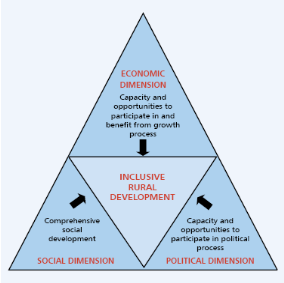
Figure 2.1. Three dimensions of inclusive rural
development (Fernando, 2008)
This figure illustrates the elements necessary for empowerment
programmes which engage in growth, capacity enhancement, competency
improvement, and opportunities. It also distinguishes approaches from the
developing world to promote rural development (Cheam Phan Viriya, October
2009)
CHAPTER THREE:
METHODOLOGY
3.1 Introduction
This chapter presents the methodological approach, the data
collection techniques and the entire process that was used to conduct the
study. It shows the methods that the researcher will use to collect and analyze
the data, the selection of the respondents, and it further spells out how the
information was obtained from respondents, analyzed and interpreted to enable
the researcher to draw logical conclusions.
Kenneth D Bailey (1978: 83) defines the methodology as the set
of methods and principles that are used when studying a particular kind of
work. A method composes all intellectual process an orderly system or
arrangements that enable a researcher to reach an aspect of knowledge by using
various techniques.
3.2. Research Design
Christensen (1991: 269); defines research design as an
outline, a plan or a strategy specifying the procedures to be used in
investigating the research problem. It is simply the framework or plan a study
used as a guide in collecting and analyzing data. For the purpose of the
current study the survey method was adopted.
The research Design of this study was an ex-post facto case
study; hence there was need of using comparative data of pre-SPREAD-NUR and
post-SPREAD-NUR project implementation. Thus, this study paid special attention
to the comparison between how the status of rural area prior to the entry of
SPREAD-NUR was and the situation after SPREAD-NUR's emergence, and the
perception of the people towards each element of the project regarding level of
Rural Development.
To gather the needed data, fieldwork was conducted in the
rural Area, ABAHUZAMUGAMBI COFFEE COOPERATIVE of MARABA, using
triangulation data collection technique. A
Questionnaire was used to get perceptions
and development status. Observations were conducted
in order to double check the validity and confidence of the collected data.
Interviews focusing on project
implementation and the assessment of development were also employed.
Ultimately, the data was analyzed as an empowerment assessment and presented in
comparative format.
This study involved both qualitative and quantitative data.
The qualitative data collection technique was subjective in nature since it
involved examining and reflecting on financial recordkeeping in business.
Numerical data analysis and statistical tests were objective in nature and
dealt with measuring phenomena. For this study, computation of percentages,
frequencies and hypotheses testing was used.
3.3. Conceptual Framework
and Methods Of Data Gathering
The following figure shows the directional conception of this
study intended to answer the research questions, as well as achieve the
objectives of the study (Cheam Phan Viriya, October 2009)
NGO and higher learning institutions
Approach
1. Health
2. Environment
3. Community development
4. Food security
5. Income generation
6. Education
Empowerment
1. Access to information
2. Inclusion and participation
3. Accountability
4. Local organizational capacity
Government
Higher Learning Institutions
NGOs
Partnership
Figure 3.1. Conceptual framework of the study
3.4. Sampling Method and
Sampling Size
ABAHUZAMUGAMBI COFFEE COOPERATIVE MARABA has 2000 members,
among them 66 respondent was select during this research. Therefore, the
researcher l completed a questionnaire survey of 66 member of ABAHUZAMUGAMBI
COFFEE COOPERATIVE living in Rural Areas basing on systematic random sampling
where by in every 30 persons one was questioned.
Several reasons guided the selection of respondents. First in
order to know about the development status of the areas, respondents in Rural
Areas were needed. Second, by approaching the households and simple families,
perceptions of the people could be measured. Finally, it was considered
important to observe the actual living standard of people in the whole area
compared to the former living standard. This provided a better understanding of
the reality rather than relying on reports of the project's staff.
3.6. Data Collection
The research needed both primary and secondary data. The
primary data were obtained using questionnaire, interview, and field
observation from the people living in Rural Areas and being members of
ABAHUZAMUGAMBI Cooperative. Secondary data were sourced from historical
archives, annual reports, monitoring and planning documents of SPREAD-NUR about
the statistical characteristics and baseline data of the project's site.
3.6.1. Primary Data
Triangulation data collection was used as a qualitative
technique to get primary data for the research. It comprises three angles:
Survey questionnaire, in-depth interview and field observation.
Questionnaire was
created to measure project components and empowerment indicators. It was
designed to compare the past and present condition of the community and
implementation of the project operation. It was designed to learn the
perceptions of the people, how they view LWF, and their satisfaction and
decision-making.
Questionnaires included three parts with 50 questions. The
first part obtained general and basic information about respondents. The second
part included six components of Rural Development in terms of access to
information, participation, accountability, and organization capacity. The
final part aimed to direct the respondent's perceptions about their overall
view of SPREAD-NUR's project.
The interview gave awareness of how
project carriers and facilitators view themselves in the roles of helping to
better the lives of poor people and their own future vision of the project
results when SPREAD-NUR withdraws.
Field observation by this
the researcher was able to double check the accuracy and validity of
information about living conditions and development. This helped to validate
and ensure that the data was gathered correctly and effectively. During the
field survey, the researcher observed the way people lived and shared
information and experiences so that answers from questionnaires and interview
could be verified.
Field observations were used to assess the accuracy and
reliability of data obtained from
people about their ideas of sharing, their awareness of
rights, level of expression, education level, infrastructure inside each
commune, health services, public services, economic conditions, capacity
building, and community organizations.
3.6.2. Secondary data
Secondary data were considered necessary in backing up the
primary data.
Available studies and information included different reports
on Rural Development, the current monitoring report and implementation progress
reports.
3.7. Data Analysis
After data collection, the following proper tools and
techniques were used for the classification and analyses of data. SPSS and
Microsoft Excel were used for the purpose of data analysis.
Tools of classification of data were frequency distribution
and charts (charts are graphical representation of data). Along this study the
following Charts were used: Pie Charts, Bar Charts, Stacked Bar Charts, and
Histograms.
After this a comparative study of living conditions was
developed in order to measure how the social wellbeing has been improved among
the producer of MARABA coffee due to the SPREAD-NUR intervention in this Field
(Coffee Production). This analysis lied on the analysis of Mode of Coffee
production, Income, Properties, Housing type, Medical insurance, Education,
Information and Communication.
CHAPTER FOUR: DATA
PRESENTATION, ANALYSIS, AND INTERPRETATION
This chapter presents results drawn from collected data. The
target population was the members of ABAHUZAMUGAMBI Cooperative, whose main
activity is to grow coffee known as MARABA Coffee.
Maraba coffee is grown in the MARABA area in southern province
of Rwanda MARABA's coffee plants are the Bourdon variety of the coffee Arabica
Species and are grown on fertile volcanic soil or on high altitude hills. The
fruit is handpicked mostly during the rain season between March and May and
brought to a washing station in MARABA, where the coffee beans are extracted
and dried. At several stages, the beans are stored according to quality.
Farmers receive credit based on the quantity of beans they provide.
In 1999 ABAHUZAMUGAMBI Cooperative was created with about 200
members. From since the Cooperative has been supported by the National
University of Rwanda and SPREAD, and working hand by hand the Cooperative has
improved the Coffee quality and penetrated on international market.
4.1. Level of Empowerment and Status of Development
The level of empowerment is going to be discussed according to
the SPREAD-NUR's components based on empowerment indicators using collected
data. This is to measure the perception of people toward SPREAD-NUR's
contributions. Also the comparison between pre-SPREAD-NUR and post-SPREAD-NUR
existence will be discussed as well in order to reflect the people's perception
on the SPREAD-NUR and their community.
4.2. Demographic
Characteristics of the Respondents
4.2.1. Distribution by Age and
Sex
Figure 2. Sex
distribution
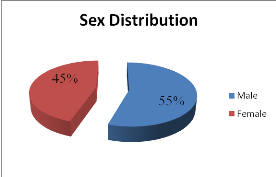
This figure 2 shows the distribution of the 66 samples by sex,
and shows that 55% of total respondents were Males and 45% were Females. To
analyze age and sex all respondents were into 4 age groups. The largest group
is 35-42 years old ranking 23 with 36% of the total respondents, this means
that the majority of samples is more than 35 years old and is likely to be
heads of families. 25% of respondents are under 35 years old and the oldest age
of all respondents is 54 years old.
Table 1. Age Group by Sex
|
Age Group * Sex Cross tabulation
|
|
Distribution of Respondents by Age and Sex
|
|
|
Male
|
Female
|
Total
|
|
28-35 Years Old
|
11
|
5
|
16
|
|
35-42 Years Old
|
14
|
9
|
23
|
|
42-49 Years Old
|
5
|
10
|
15
|
|
49-56 Years Old
|
6
|
3
|
9
|
|
|
36
|
27
|
63
|
Source:
Primary Data
Figure 3.Distribution of
respondents by Age and sex
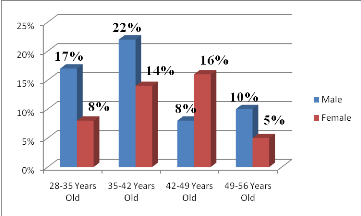
4.2.2. Distribution by marital
status
The below figure shows that the majority of the respondents
are married . They account for about 52% of the total sample. About 41% are
widows and the rest are single (8%).
In brief the main demographical profile of respondents is
married and mature more than 35 years old.
Table 1. Marital
status
|
Marital Status
|
|
|
Frequency
|
Percent
|
|
Single
|
5
|
8
|
|
Married
|
34
|
52
|
|
Widow (er)
|
27
|
41
|
|
Total
|
66
|
100
|
Source:
Primary Data
Figure 4. Marital Status of
Respondents
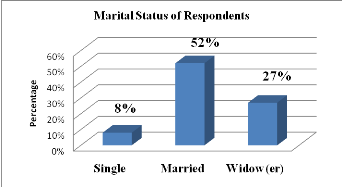
4.2.3. Occupation and Education
Level characteristics of respondents Household size
The following figure shows that the majority of respondents
are Farmers with 47% of the total sample; 6% represents self-employed
respondents, 15% represents traders, 18% represents Local government employed,
9% represents Labor seller, while 5% represents Breeding. The main factor that
they are concentrated in farms is because the total sample was composed of the
member of ABAHUZAMUGAMBI Cooperative and that the main activity of this
cooperative is oriented in coffee plantation.
Table 2. Occupation by
Respondents
|
Occupation of Respondents
|
|
Frequency
|
Percent
|
|
Farmer
|
31
|
47
|
|
Self-employed
|
4
|
6
|
|
Trading
|
10
|
15
|
|
Local government employed
|
12
|
18
|
|
Labor seller
|
6
|
9
|
|
Farming and Breeding
|
3
|
5
|
|
Total
|
66
|
100
|
Source: Primary
Data
Figure 5. Occupation of
Respondents
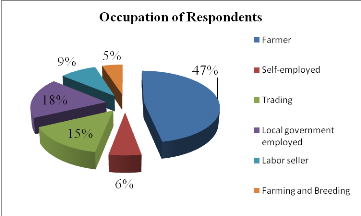
Respondent's education level shows that the majority of them
are concentrated in those who have completed primary 39%, those who have
completed Secondary school are represented by 29% of all respondents, those
who have Non-formal education are represented by 20% of all respondents, and
those who have Vocation and Artist level are represented by 12% of all
respondents.
Figure 6.
Education level of respondents
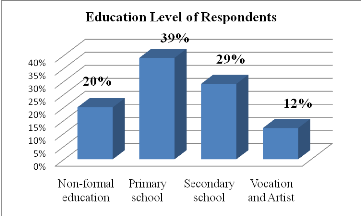
The below table shows that the household size s' pattern of
respondents is more represented by the household within 4-5 persons that is why
the on average each household counts 5 persons.
Table 3. Household
size
|
Household size
|
|
Minimum
|
Maximum
|
Mean
|
|
2
|
9
|
5.3
|
Source: Primary data
4.3. Coffee production and
Quality of production
4.3.1. Coffee Plantation and
production
Coffee as cash crop and that plays an important role in
improving social welfare in rural area has kwon a large development in MARABA
Sector, and many households are engaged in growing coffee. Basing on collected
data, all respondents reported to have about 16958 of coffee trees which are on
the stage of producing, and on average each households counts about 308 coffee
trees.
Table 4. Coffee
trees
|
Coffee Trees
|
|
Minimum
|
Maximum
|
Sum
|
Mean
|
|
50
|
1000
|
16958
|
308.3273
|
Source: Primary
data
Table 5. Coffee production
in Kgs
|
Minimum
|
Maximum
|
Sum
|
Mean
|
100
|
|
2000
|
33916
|
616.65
|
|
Source: Primary
data
The total production of those 16958 trees is evaluated on
33916Kg per season, and on average each households is likely to produce 617kg
of coffee per season.
Figure 7.
Distribution of Coffee production
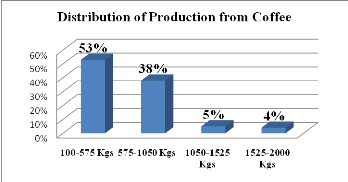
The income from coffee plantation is important and is
contributing in the amelioration of social wellbeing of those household, and
with the intervention of SPREAD-NUR the coffee production has been evaluated on
good scale, whereby, now all respondent are likely to receive 5,087,400 Rwf per
season or 92,498Rwf each household on average per season. This amount is so
important, is used in many things such providing good health care, food
security in sampled members of ABAHUZAMUGAMBI Cooperative.
Table 6. Income from
coffee
|
Income from Coffee Production
|
|
Minimum
|
Maximum
|
Sum
|
Mean
|
|
15000
|
300000
|
5087400
|
92498.18
|
Source:
Primary data
4.3.2. Washing System
Table 7. Washing System
|
|
Frequency
|
Percent
|
|
Traditional Washing System
|
2
|
3
|
|
Modern Washing System
|
64
|
97
|
Source: Primary
data
Figure 8. Coffee washing
system
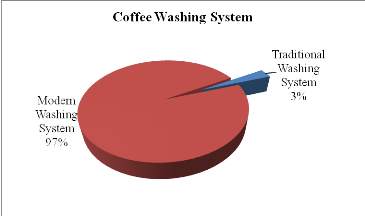
The above figure shows that the large part of respondents use
Modern washing system (97%), and the remaining part of 3% use Traditional
System. These figures explain the quality of coffees produced in this area,
because are well managed from the beginning step to the step of selling. Due to
the modern washing system, MARABA coffee has reached a high sound, because it
is sounding not only in Rwanda but also at the international level, means that
MARABA Coffee has a non-negligible Marketing around the world.
4.3.3. Use of Fertilizer,
Pesticides, and Pest control
Respondents know the role of using inorganic fertilizer in
coffee plantation, because 91% of total respondents agreed to use inorganic
while only 9% of them disagreed.
Figure 9. Use of Inorganic
fertilizer and Pesticides
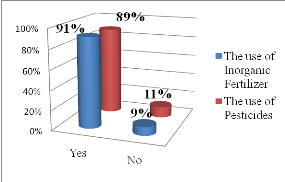
In order to protect and to increase the quantity of coffee
from plantations, 89% of respondents agree to use pesticides and 11% of them
disagree. Those figures show that pests which can reduce quantity in plantation
are controlled. And only 6% of respondent claims their Coffee plantation face
pest and/ or other problems which can reduce production. The logic behind is
that as the use of fertilizer and pesticides increases the quantity produced
increases with good quality.
The below figure shows that due to the intervention of
SPREAD-NUR pest and other problems which may reduce coffee production have
been reduced. 94% of respondents agree this assertion while 6% disagree but by
stating that regardless this, they have experienced an amelioration in their
plantation due to the assistance of SPREAD-NUR.
Figure
10. Contribution of SPRAED-NUR on Coffee production
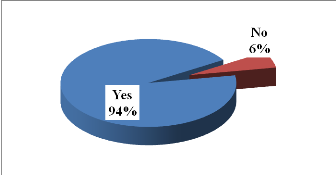
4.3.4. Channels of produced
quantity
The below table shows that the main channel of coffee produced by
respondents is Cooperative 94%, and local market is less used 6%, the use of
cooperative as the main channel of their production help them to market their
production with the assistance of SPREAD-NUR, where by quantity bought by
cooperative is well kept and managed, with a consolidated ameliorations to
reach international markets.
Figure
11. Main Channel of coffee production
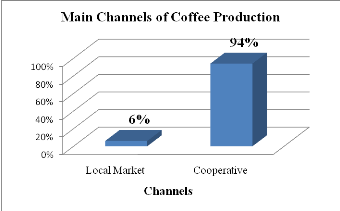
4.4. Perception toward
Income generating which increases earnings
Table 8. Bank Account
|
Frequency
|
Percent
|
Valid Percent
|
Cumulative Percent
|
Yes
|
|
62
|
93.9
|
93.9
|
93.9
|
No
|
|
4
|
6.1
|
6.1
|
100.0
|
Total
|
|
66
|
100.0
|
100.0
|
|
|
Source: Primary
data
As illustrated in the above table , 94% of all respondents has
a bank account, and as illustrated in the below figure 62% of all respondents
is engaged in farming, 14% in raising animals ,6% in labor sale, 9% in Trading,
and 9% in Farming and Raise livestock as alternative activities to generate
income a part from coffee plantation. But the main income generating activity
is based on agriculture of coffee.
Due to the contribution of SPREAD-NUR in agriculture of
coffee, respondent are away of receiving enough income which allow them to put
aside a portion for saving and business.
Table 9.
Income Generating activities
|
Frequency
|
Percent
|
Cumulative Percent
|
Farming
|
|
41
|
62.1
|
62.1
|
Raise livestock
|
|
9
|
13.6
|
75.8
|
Labor sale
|
|
4
|
6.1
|
81.8
|
Trading
|
|
6
|
9.1
|
90.9
|
Farming and Raise livestock
|
|
6
|
9.1
|
100.0
|
Total
|
|
66
|
100.0
|
|
|
Source: primary data
Figure 12.
Income generating activities
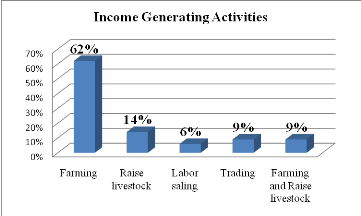
The below figure shows that 60% of total respondents agreed
that Income from coffee has an important contribution in starting the above
mentioned income generating activities or projects, 19% of total respondents
agreed that Loans from ABAHUZAMUGAMBI Cooperative have contributed in starting
the above income generating activities, while 10% agreed to use income from
other activities.
Figure 13. Main source of
income to start income generating projects
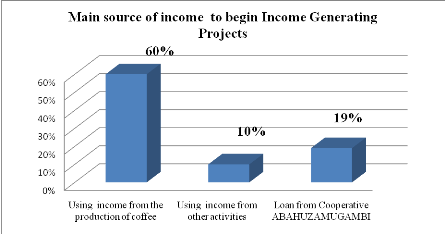
4.5. Perception toward Food
Security
Table 10. Food condition
|
Frequency
|
Percent
|
Cumulative Percent
|
Sufficient
|
|
36
|
60.0
|
60.0
|
Insufficient
|
|
24
|
40.0
|
100.0
|
|
Source: Primary data
Figure 14. Food condition
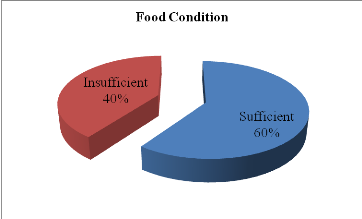
From the above table and figure, among the member of
ABAHUZAMUGAMBI surveyed, 60% of them rates food condition Sufficient, while 40%
of them see that food condition in their respective households is Insufficient.
This insufficient in food taken per day was supported by the number of meals
that they take per day, as the below figure demonstrates the majority of
respondents take meals Two times per day (67%), while the remaining part of
respondents reported that it takes meals Three time per day (33%), and among
respondents there is no case of persons who take meal once per day. Even though
the majority of respondent agrees that their meals in take have been increased
and ameliorated due to the intervention of SPREAD-NUR in the plantation of
coffee in their area.
Figure 15. Meals in take per day
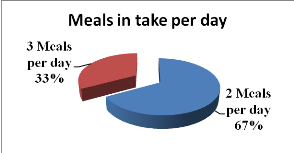
Figure 16. Food
control
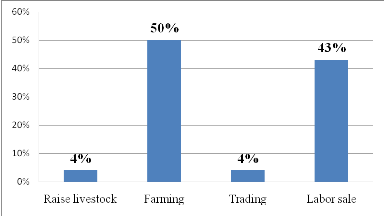
In order to control food quality and quantity in their
households when food is not enough, most of respondents reported that they take
orientation in farming (50%), 43% of them takes orientation in labor sale, 4%
Raises livestock, and 4% in trading.
As the members of ABAHUZAMUGAMBI Cooperative are working with
SPREAD NUR they agree that there has been an improvement in food in take, this
means that the intervention of SPREAD-NUR in rural area is developing the way
of living of rural people. It is also understandable that with the improvement
of food many diseases from unbalanced food are eliminated, and therefore
population are away of concentrating on improving their social wellbeing toward
Development. 68% of total respondents reported that food served in their
household has been improved while only 32% disagreed this assertion, as shown
in the following table and figure.
Table
11. Improvement in food served
|
Frequency
|
Valid Percent
|
Cumulative Percent
|
Yes
|
|
41
|
68.3
|
68.3
|
No
|
|
19
|
31.7
|
100.0
|
Total
|
|
60
|
100.0
|
|
|
Source: Primary data
Figure
17. Food improvement
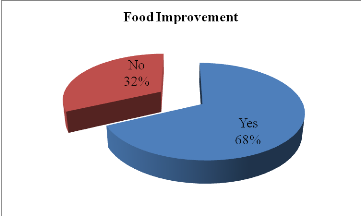
4.6. Perception toward
Basic health and HIV and AIDS
According to respondents' views, the awareness, which measures
access to information, was highly accepted among respondents
regarding health. Almost all of respondents said that they could get access to
health information and participate in the campaigns. In this regard, many
activities and group education about health have been undertaken to share
information, it also plays important role changing from the use of traditional
treatment like superstitious ways to scientifically medical treatment.
Regarding health campaign organizers, the respondents ranked SPREAD-NUR as the
leading provider of information, accounting 47% of all respondents for
campaigning followed Health center/Health post with 32% of all respondents,
Village health volunteer with 12%, and TV/Radio with 9% of all respondents.
This suggests that SPREAD-NUR is actively involved in and helps advocate health
sector for a better health environment.
Figure 18. Main source of
information on basic health and HIV/AIDS
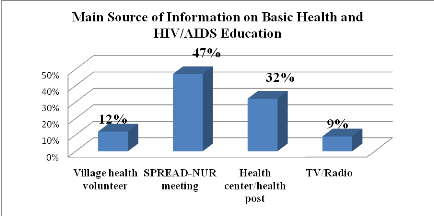
Inclusion and Participation in health training and services is
another measurement of awareness. The below Figure 9 shows respondents use to
participated in HIV/AIDS training and awareness. Impressively 100% of
respondents participated in health activities. They were well aware of the
issue and willing to participate for their own good and their community. Figure
9 and 10 reveal how the people participated in HIV/AIDS education and who
provided the information.
Dramas and Dances and education Group to houses, were
initiated by ABAHUZAMUGAMBI Cooperative under SPREAD-NUR. They stand for the
largest networking groups in disseminating training and health education. The
majority of respondents participated in them 62% in Education Group and 38% in
Dramas and dances. It is a good learning by direct involvement in the
activities at sites so people benefit comprehensively.
Figure 19. Health activities
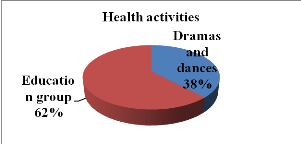
As illustrated in the below Figure 20, 68% of the respondents
complained that they are satisfied with the health condition in their homes.
They also mentioned about the lack of resources and training for health. Only
some 26% said it is bad. However, after SPREAD-NUR began its activities, 68%
and 6% of the sample viewed that health conditions has been improved and now
they rate it to be good and very good respectively in their respective
households. This finding suggests that 74% (68%+6%) of respondents is satisfied
with SPREAD-NUR's heath care activities and that health component of projects
undertaken by SPRAED-NUR are adequate for Rural Development.
Figure 20. Health situation
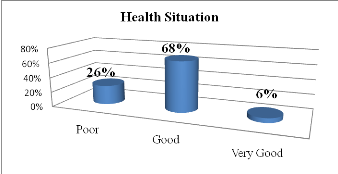
4.7. Perception toward
Environment
Table
12. Environmental threats and problems
|
Frequency
|
Percent
|
Cumulative Percent
|
Water pollution
|
|
42
|
77.8
|
77.8
|
Air pollution
|
|
8
|
14.8
|
92.6
|
Forest fire
|
|
4
|
7.4
|
100.0
|
Total
|
|
54
|
100.0
|
|
|
Source: Primary data
The above table shows the major current environmental threat
and problems faced by environment in the interested region. As illustrated, the
area is facing Water pollution, Air pollution, and Forest fire
of the total respondents. The MABARA area is also one of the arable areas in
Rwanda with high quantity of coffee production with good quality, therefore it
needs a protection from human-made threats. The below figure 21 shows the
threats and problems currently in the area. As displayed, there are three main
threats and problems perceived by the respondents: Illegal Water pollution
(78%), Air Pollution (15%), and forest fire (7%).
Figure 21.
Environmental threat and problems
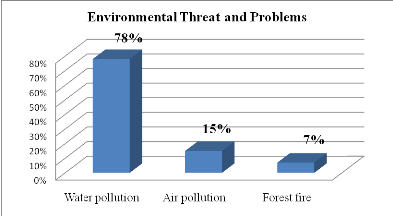
The below figure 22 shows that 100% of respondents agreed on
the contribution of SPREAD-NUR in Natural resource protection.
Figure 22.
SPREAD-NUR and natural resource protection
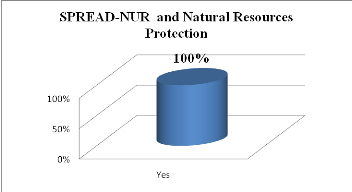
The following figure shows that, regarding status and updates
on natural resources, 36% of respondents received information
regularly through Radio, 24% through Radio and Cell-phone, 21% through radio,
television, and cell-phone, and 19 through radio and television. This means
that the level of access to information regarding environment, Health
and other mean of development is good, because the majority of respondents have
many way of receiving important environmental and health updates
information which goes with rural development. This resulted in responsible
environment authority for the environment and health as the measures
of welfare.
Figure 23. Means of
getting information
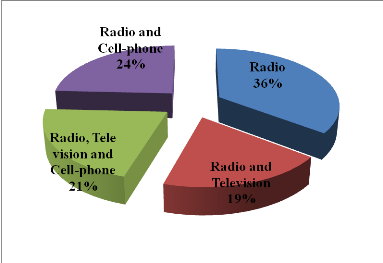
Table 14 and figure 24 show the level of awareness established
by SPREAD-NUR's efforts such as how its contribution has ameliorated the type
of lighting in the area, 37% of respondents reported that their type of
righting has been improved because now days they are using electricity as the
major source of lighting energy. According to the figure 24, the level of using
different means of lighting has dramatically changed. The key aspect here is
SPREAD-NUR awareness because its role is to manage, organize, and support the
members of ABAHUZAMUGAMBI Cooperative, according to their needs.
Table 13. Main Sources of lighting energy
|
Frequency
|
Percent
|
Cumulative Percent
|
Petroleum
|
|
41
|
62.1
|
62.1
|
Electricity
|
|
25
|
37.9
|
100.0
|
Total
|
|
66
|
100.0
|
|
|
Source: primary
data
Figure
24. Main sources of lighting energy
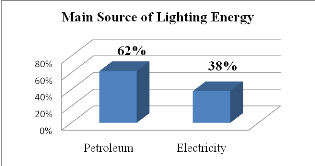
4.8. Perception toward
Rural Development
Basing on results from collected data and how respondents used
to evaluate the pertnership of SPREAD-NUR in coffee production and Rural
Development ; Access to information, Inclusion and participation,
Accountability, and Local organizational capacity have been improved when
SPREAD-NUR start to work with ABAHUZAMUGAMBI Cooperative and now are highly
rated among the members of ABAHUZAMUGAMBI Cooperative as shown in the table 15
of empowerments.
Those empowerments have increasingly integrated to Rural
Development are highly rated as the main keys to inclusive Rural Development
among respondents. Respondents rate those empowerment between
64.7% and 94.2% to be the major factors
towards Rural development as the target of SPREAD-NUR (Table 16).
Table 14.
Empowerment
|
Empowerment
|
Initial
|
Extraction
|
Percentage
|
Access to information (1)
|
|
1.000
|
.725
|
83.1%
|
|
|
.937
|
|
|
1.000
|
.932
|
93.2%
|
|
|
.932
|
|
|
1.000
|
.846
|
89.15%
|
|
|
.937
|
|
|
1.000
|
.975
|
96.2%
|
|
|
.949
|
|
Source: Primary data
Table 15. Inclusive Rural
Development
|
Component
|
1
|
2
|
3
|
4
|
Extraction(%)
|
1
|
|
.942
|
.315
|
-.068
|
-.095
|
94.2%
|
2
|
|
-.153
|
.669
|
-.030
|
.727
|
66.9%
|
3
|
|
.142
|
-.152
|
.955
|
.210
|
95.5%
|
4
|
|
.264
|
-.656
|
-.286
|
.647
|
64.7%
|
|
Extraction Method: Principal Component Analysis.
Rotation Method: Varimax with Kaiser Normalization
Source:
Primary data
This means that joined people has experienced the active
participation of SPREAD-NUR in this aspect of rural development. The above
paragraphs support our hypothesis; therefore Higher learning institutions
contribute to the process of Rural Development in Rwanda.
Access to information
Inclusion and participation
Accountability
Local organizational capacity
SPREAD-NUR
83.1% 93.2% Empowerment 89.2%
96.2%
Inclusive Rural Development
94.2% 66.9% 95.5%
64.7%
CHAPTER V. CONCLUSION AND
RECOMMENDATIONS
5.1. Conclusion
In fighting poverty, which is rural phenomena and to promote
sustainable development high emphasis is placed on education both nationally
and internationally. Studies indicates that productivity is affected by level
of education and quality for as well
The first objective was to identify the role played by
National University of Rwanda in rural development of Rwanda. The findings
described the role played by National University of Rwanda in collaboration
with SPREAD in Chapter 4 and later on viewed the perceptions of the people. The
data showed that people are vastly empowered in the coffee production.
The second objective described the understanding on
community's perception to SPREAD-NUR's contributions in development status of
rural area. The results are summarized as follows: 74% of the respondents
complained that they are satisfied with the quality of basic health that they
are enjoying. They also mentioned that their coffee plantations have been
ameliorated and that they expect high quantity and good quality in their
production. However, after SPREAD-NUR became involved in MARABA coffee
production, 97% of the sample viewed that the washing system has been improved.
In the same way, basic health and HIV/AIDS awareness have been improved.
The third objective was to recommend measures and model of
empowerment to enhance the effectiveness of SPREAD-NUR in promoting rural
development in Rwanda. To fulfill this objective, the role of partners such as
SPREAD-NUR and targeted local population is in Chapter 4. The level of their
participation in rural development is high and active in regards to both
financing and coordinating projects toward rural development. Some operations
of SPREAD-NUR in MARABA also overlap with Local Government's operations but
they have prevented conflicts and/or transformed them into cooperation and
technical assistance for each other. They also came up with solutions for
exchanging opinions to facilitate and fill gaps in rural development in order
to serve the community together synergically.
To conclude the study, this research discovers that SPREAD-NUR
is promoting Rural Development to an extent which covers six modules.
SPREAD-NUR has helped the community by empowering them to a degree of
satisfactory development perceived by the people. Overall, the people think
that SPREAD-NUR plays a very important role in enhancing their livelihood and
social welfare through its contribution in ameliorating coffee plantation and
production of ABAUZAMUGAMBI Cooperative Members, if compared to the past.
MARABA Coffee Producers are being organized and decentralized, food is secure
due to the income from coffee which permit them to provide with other kind of
good and when food is not enough in their households income from coffee is
used, more jobs and income are being generated, natural resources are
preserved, education is improved, health conditions and services are
strengthened, and the people are better prepared for selfe-sufficient.
Next, local authorities also play vital roles as catalysts in
cooperation and facilitation in SPREAD-NUR's operation in this rural area. Last
but not least, empowerment has well promoted rural development by adequate
responds in terms of empowerment's indicators: access to information, inclusion
and participation in activities, accountability, and local organizational
capacity in the project's elements.
5.2. Recommendations
In the context of the SPREAD-NUR, even though the approach is
promoting Rural Development, there are some gaps within SPREAD-NUR's coverage.
They are at the level of the participation of targeted population in activities
towards rural development lanced by SPREAD-NUR, and of updates to information
and accountability from actors in the development sector. Taking into
consideration findings of this research and to cope with gaps revealed
following the survey, these recommendations are offered in order to concentrate
the SPREAD-NUR's policies for Rural development:
· Education and training need to be placed at the
forefront of the rural development agenda in order to fight the evident extreme
poverty and hunger in rural areas; to break the poverty induced poverty result
cycle of rural life; to ensure sustainable agriculture, and to build the human
capacity needed for development.
· National University of Rwanda should enact and apply
strict valuable interest for rural development, and encourage Rural people to
cooperate friendly in programs for development.
· SPREAD-NUR should show its caring interest in the poor
by providing helpful project to the poor as soon as they require it.
· The ABAHUZAMUGAMBI Cooperative Member should work
closely with SPREAD-NUR for periodic surveys on perception towards rural
development.
After that they have been developed, the researcher is
confident that these practices will be useful for NUR through its implication
in rural development and for rural communities inside and outside where NUR
operates. Before putting these kinds of policies into practice, unique and
potential aspects of local communities will always need to be studied in-depth
to fit with their environmental and needs in the future. Also, SPREAD-NUR's
project and management capacity are crucial to carrying out such an approach.
Consequently the most important experience from SPREAD-NUR's partnership is
that rural people should have both the commitment and will to promote a
self-sustaining community through the principles of self-help, self-control,
and self-organization.
REFERENCE
Calestous Juma,2000, Agricultural innovation and
economic growth in Africa: renewing international
cooperation, Int. J. Technology and Globalization, Vol. x, No. x, xxxx
Harvard Kennedy School, USA
Cheam Phan Viriya, October 2009, NGO's Approach to
Community Development in Rural Cambodia, Cambodian Institute for
Cooperation and Peace working Paper No. 30.
Christensen, Lorry B., 1981, Experimental
Methodology, Boston, USA
Edaurdo Rams, and Maria del Mor Delgado, 2005, Higher
Education for Rural Development: the experience of the University
of Cordoba, International Institute of Education Planning, Paris
FAO/UNESCO Seminar, 5-7 November 2002, Education
for Rural Development in Asia: Experiences and Policies Lessons,
International Institute for Education Planning, Paris, France. PP 11- 50
Faustine K.Bee,2001, Empowering Farmers
Cooperatives through Fair Trade: The Case of three Coffee Cooperative unions in
Tanzania; A Paper submitted at the Cooperative College Annual
Symposium September 2001
Fred N. Kerlemyer, 1964, Fundamental Behavioral
Research Educational and Psychological Inquiry, New York
University, Holt Rhine Hart, London, United Kingdom
Gills Malcolm et al, 1987, Economics
Development, Northern, New York
Grinnele Richard M. Tr and Williams Maryaret 1980,
Research in Social Work, A Primer, F.E Peacock
Publisher, inc. Hasco Illinois
Hagen Everelt, 1968, The Economics of
development, Home Wood, USA
http://www.fao.org/sd/erp/
accessed on 20 August 2010
James E. Bartlett, II Chadwich C. Higgins, 2001,
Organizational Research: Determining Appropriate Sample Size in
Survey Research, Information Technology, Learning and Performance
Journal, Vol. 19, No. 1, Spring 2001, pp 43-50.
Kenneth D.Baily 1978, Methods of Social
Research, M.C. Millan Publishing, New York
Taylor P and J Fransman (2004), Learning and
teaching participation: exploring the role of higher learning institutions as
agents of development and social change, working paper 219,
Falmer, Institute of Development Studies, United Kingdom
www.wikipedia.org
Appendices
QUESTIONNAIRE
My name is GASHEMA Vincent and I am an undergraduate student
at National University of Rwanda, in the Faculty of Economics and Management,
Department of Economics, Option of Money and Banking. I am doing a research
entitled «ANALYZING THE CONTRIBUTION OF HIGHER LEARNING INSTITUTIONS ON
RURAL DEVELOPMENT IN RWANDA: Case of The Study SPREAD-NUR and ABAHUZAMUGAMBI
COFFEE COOPERATIVE MARABA» and I would like to carrying out this survey in
order to get data for the completion of my Bachelor's degree in Economics. I
would like to ensure to all respondents completing this survey questionnaire
that all of your answer will be kept in confidentiality for academic purpose
use only. Thank you for your cooperation.
A. Identification
Q1. Sex: Male Female
Q2. Age: How old are you?
Q3. Marital status: Single Married
Widow(er) Divorced
Q4. Occupation: What was your Occupation before the
implementation of SPREAD-NUR?
Farmer
Self-employed Seller
Local government employed Labor
seller Breeding
Q5. Apart from coffee farmer what is your other occupation?
Farmer
Self-employed Seller
Local government employed Labor
seller Breeding
Q6. Education: Before SPREAD-NUR arrived what was you education
level?
Non-formal education Primary school
Secondary school High school
Vocation and Artist
Q7. To day what is you education level?
Non-formal education Primary school
Secondary school
High school Vocation and
Artist
Q8. How many persons were they in your family before SPREAD-NUR
arrived?
Q9. How many persons are they in your family to day?
B. Coffee production and Quality
Q10. Before the SPREAD-NUR arrived, had you coffee plantations?
Yes No
a) If yes, how many trees of coffee had you?
b) On which area( are) c) with which production
per season (Kgs)
Q11. To day and after SPREAD-NUR arrived, how many trees of
coffee do you have?
a) On which area (are)? c) with which production
(Kgs)?
Q12. Which washing system for coffee did you use before
SPREAD-NUR arrived?
Traditional Washing System Modern
Washing System
Q13. Which washing system for coffee are you using after
SPREAD-NUR arrived?
Traditional Washing System Modern
Washing System
Q14. Did you add inorganic fertilizer in your coffee plantations
before SPREAD-NUR arrived?
Yes No
Q14a. If yes, which quantity in Kgs
Q15. To day, do you add inorganic fertilizer in your coffee
plantations?
Yes
No
Q15a. If yes, which quantity? Kgs
Q16. Did you use pesticides before SPREAD-NUR arrived in your
plantations?
Yes
No
Q16a. If yes, which quantity in Kgs
Q17. Do you use pesticides in your plantations?
Yes No
Q17a. If yes, with which quantity in Kgs
Q18. Did your coffee plantations face pest problem and/or other
problems which may reduce production before SPREAD-NUR arrived? Yes
No
Q19. Do your coffee plantations face pest problem and/or other
problems which may reduce production to day? Yes
No
Q20. Do you think that pest and other problems which may reduce
coffee production in your plantation have been reduced after SPREAD-NUR
arrived? Yes No
Q21. Where did you use to sell your production (Coffee) before
SPREAD-NUR arrived?
Local Market Cooperative
Q22. Where do you use to sell your production (Coffee) after
SPREAD-NUR arrived?
Local Market Cooperative
C. Rural Development Status
Income generation
Q23. Had you a bank account before SPREAD-NUR arrived? Yes
No
Q24. Do you have a bank account to day?
Yes No
Q25. What kinds of jobs/ income generating activities did you
engaged in before the coming of SPREAD-NUR?
Farming ? Raise livestock
Labor sale Trading
Q26. What kinds of jobs/income generating activities are you
engage in after the coming of SPREAD-NUR?
Farming Raise livestock Labor
sale Trading
Q27. If you have chosen at least one among the above projects,
how did you begin?
Using the income from the production of coffee
Using the income from other activities you have
Loan from Cooperative ABAHUZAMUGAMBI
Food Security
Q28. How did you rate your family food condition before
SPREAD-NUR came?
Sufficient Insufficient
Q29. How many times did you use to eat per day before SPREAD-COME
came?
Q30. To day, how do you rate your food condition after SPREAD
came?
Sufficient Insufficient
Q31. How many times do you use to eat per day after SPREAD-COME
came?
Q32. Had any member of your family experienced under nutrition
problem before SPREAD-NUR came? Yes No
Q33. Had any member of your family experienced under nutrition
after SPREAD-NUR came? Yes
No
Q34. If food for your family is not enough, what do you do?
Raise livestock Farming
Trading Labor sale
Q35. Do you think that the quality of food that served in your
household has been improved? Yes No
Health
Q36. How did you rate health services at that time before
SPREAD-NUR?
Very poor Poor Good
Very good
Q37. How do you rate health services at this time after
SPREAD-NUR came?
Very poor Poor Good
Very good
Q38. Had all members of your family medical insurance before
SPREAD-NUR come? Yes
No
Q39. Do all member of your family have medical insurance? Yes
No
Q40. Do you participate in HIV/AIDS education?
Yes No
Q40a. If yes, how specifically do you participate?
Dramas and dances Education group
Q41. From whom do you learn about basic health and HIV/AIDS
education (indicate your special choice)
Village health volunteer SPREAD-NUR
meeting
Health center/health post TV/Radio
Environment
Q42. What is the major current environmental threat and problem
faced by environment in your region?
Water pollution Air pollution
Forest fire Wildlife hunt
Q43. Do you think activities undertaken by SPREAD-NUR are
performed in the way protecting natural resources? Yes
No
If no, what else should be done?
Q44. What type of lighting did you use before SPREAD-NUR
came ?
Candle Petroleum
Electricity Salar energy
Q45. What type of lighting do you use ?
Candle Petroleum
Electricity Salar energy
Q46. How did you use to get information before SPREAD-NUR
came ?
Radio Television
Cell-phone
Q47. How do you use to get information after SPREAD-NUR
came ?
Radio Television
Cell-phone
Q48. How do you evaluate the pertnership of SPREAD_NUR in coffee
production............................................................................................................................................................................................................................................................................................................
| 

